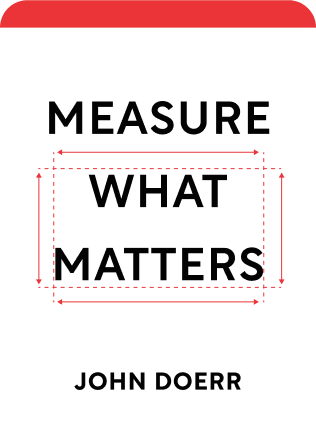

This article is an excerpt from the Shortform summary of "Measure What Matters" by John Doerr. Shortform has the world's best summaries of books you should be reading.
Like this article? Sign up for a free trial here .
What are OKR goals, and how do you set them? How can OKR goal-setting help you achieve your goals?
OKR goals are a set of metrics that you determine for your company based on the OKR goal-setting guidelines. When you set your OKR goals, you should set several sets of goals that will allow you to adjust as you monitor your progress.
Keep reading to find out how OKR goals work, and how you can use them in your business.
What Are OKR Goals?
The first step of the OKR process is figuring out the “Os,” your objectives. Every individual and team in the company will have their own objectives and key results, but in order for these OKRs to be meaningful, they need to align with the organization’s highest objectives, so start with these.
To determine your organization’s highest objectives, ask, “What are the most important tasks we need to accomplish in the next three months, the next six months, and the next year?”
You can’t do everything. Answering these questions gets you focused on the few things that have to get done for the company to succeed. These are your objectives.
Your biggest priorities, the OKR goals that everyone in the organization is working toward, are your organization-level objectives, or company-wide objectives.
Once you’ve identified your organization-level objectives, departments, teams, and individuals can identify their own objectives. These objectives often feed into and support organization-level objectives, so determining them is a matter of starting with the top objectives and figuring out what sub-goals you need to meet to achieve them. (We’ll cover how to create this alignment in the next chapter.)
At each tier, focus on three to five objectives. Any more than this, and your focus will be too dispersed.
Identify Key Results
After you know your priorities, your objectives, you can start to plan how to achieve them. Key results are the steps that get you there. For each objective, decide on three to five key results—sub-goals that are specific, measurable, and time-bound, and that collectively ensure you’ll attain your objective.
The three sets of key results (KRs) below are all proposed paths toward the objective of winning the Indy 500. What differentiates the strong key results from the weak and so-so key results?
| Weak KRs | So-So KRs | Strong KRs |
| Objective: Win the Indy 500.KR #1: Achieve a faster lap speed.KR #2: Decrease time during pit stops. | Objective: Win the Indy 500.KR #1: Achieve a lap speed that’s 2% faster.KR #2: Decrease time during pit stops by an average of 1 second/stop. | Objective: Win the Indy 500.KR #1: Achieve a lap speed that’s 2% faster.KR #2: Decrease time during pit stops by an average of 1 second/stop.KR #3: Decrease pit stop errors by half.KR #4: Spend 1 hour/day practicing pit stops. |
The Problem with the Weak KRs: These key results are measurable, but they aren’t specific. How much faster does your lap speed need to be to win the Indy 500? By how much time do you need to decrease pit-stop length?
The Problem with the So-So KRs: These key results are better because they’re measurable and specific. In the beginning, many of your KRs will look like these, and that’s fine. But there’s still a problem. Achieving a faster lap speed is relatively straightforward, but how do you decrease your pit-stop time? The strongest KRs answer how.
Quantity and Quality OKRs
Pair “quantity OKRs” (make ten sales calls) with “quality OKRs” (earn two new orders). This ensures that you don’t sacrifice the quality of your product or service in the name of meeting your ambitious quantitative OKR goals.
| Quantity Objective | Quality Objective | Result |
| Process 10x more vouchers this quarter | Make 10% fewer errors in voucher processing | Processing is more efficient |
| Custodial staff cleans 3,000 square feet per hour | Custodial staff receives an average quality score of 8 or higher. | Office buildings are cleaner and cleaning takes less time |
| Developers create three new product features by Aug. 14th | Testing finds fewer than five bugs per feature | Code for features is cleaner |
Designate an “OKR Shepherd”
In order for the OKR system to work, everyone, from the CEO to the lowest-level employee, has to take part. No one can opt-out. But you’ll likely encounter people who resist the system or procrastinate in setting their OKRs. It’s useful to put someone in charge of keeping the rest of the team or organization accountable for setting and evaluating their OKRs.
Aligning Your OKR Goals
How to Implement OKRs for alignment: Everyone in the company makes their own OKRs, and everyone’s OKRs are visible to everyone else. This provides the transparency needed for people to connect their goals with those of the company and their peers to make OKR goal-setting easier.
Research shows that highly-aligned companies are twice as likely as non-aligned or badly-aligned companies to be top performers.
For employees to align their goals with their company’s goals, they need to know their company’s goals. This seems obvious, but, according to one study, only 7% of employees actually know what their company’s overarching strategy is and how they’re expected to contribute to its success. This is why the transparency of OKRs is so important.
The Benefits of Transparency
In order for everyone’s goals to be aligned and contributing to the same ultimate objective, everyone’s goals, and their progress toward those goals, need to be transparent. The OKR system builds this necessary transparency into the process. CEOs can look at the goals of their executives, managers, and junior staff, and junior staff can (and should) look at the goals of their bosses and the CEO—everything is public.
Aside from alignment, there are other benefits of transparency:
Benefit #1: Transparency Increases Productivity and Engagement
Studies show that you’re more likely to achieve goals that you’ve made public, and OKRs are always public. Similarly, 92% of employees are more motivated to reach their goals at work if their progress is made visible to their colleagues, as it is in the OKR system.
Benefit #2: Transparency Fosters Collaboration
Everyone should be setting OKR goals. If your colleagues know your goals, and they know how much (or how little) progress you’ve made toward them, they have a better sense of how and when to help. This fosters support among peers and strengthens workplace morale.
Additionally, your goals might be similar to a colleague’s, and, consequently, you might have resources, strategies, or information that could help your colleague reach her goals. You can’t know which of your resources could be useful to your peers if you don’t know what they’re working on.
Benefit #3: Transparency Reduces the Risk of Redundant, Overlapping Goals
In large companies, people often work on the same thing, and toward the same goal, without realizing it. Making sure everyone knows everyone else’s goals helps keep employees from performing redundant tasks and, consequently, saves the company time and money.
So what are OKR goals? OKR goals are your metrics for how you succeed, and allow you to adjust based on your progress

———End of Preview———
Like what you just read? Read the rest of the world's best summary of John Doerr's "Measure What Matters" at Shortform .
Here's what you'll find in our full Measure What Matters summary :
- How Google uses OKRs to rally 100,000 employees in the right direction
- How to avoid setting useless OKRs, and how to set great ones
- Key subtle behaviors your team must master to make OKRs work






